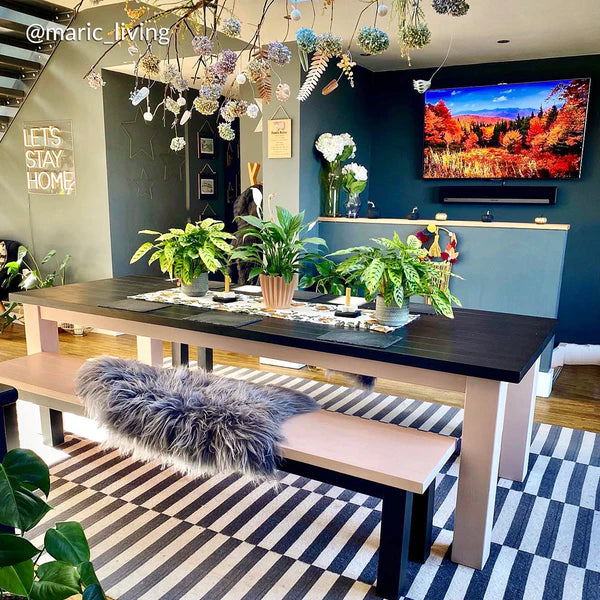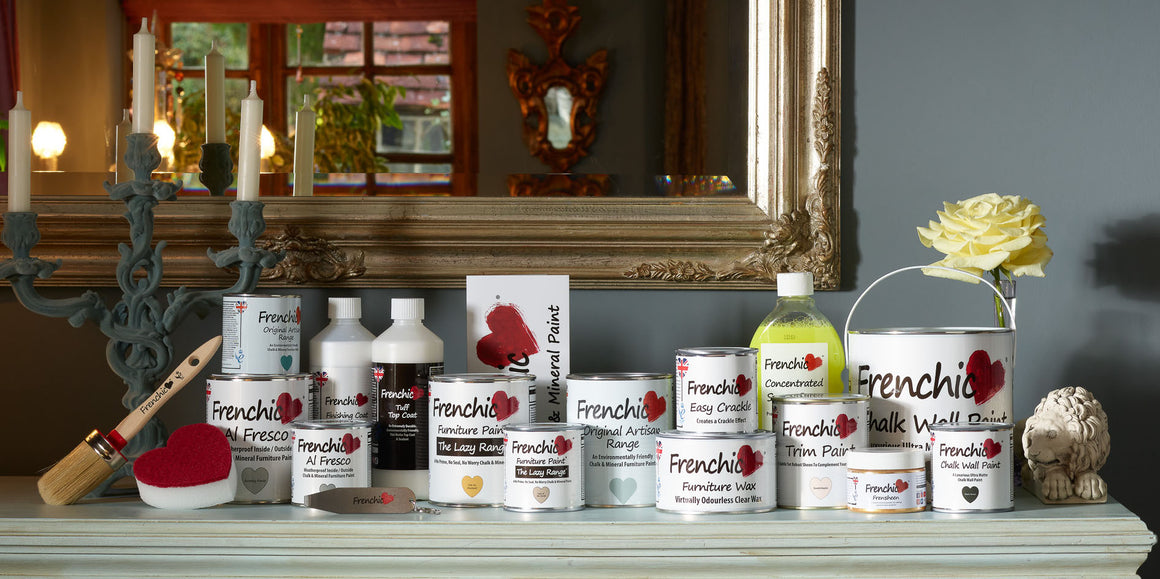-
Shop
- Paint Colours
- Original Artisan Range
- The Lazy Range
- Al Fresco Inside/Outside Range
- Chalk Wall Paint
- Chalk Wall Paint Samples
- Trim Paint
- Metallics
- Easy Crackle
- Frenshimmer
- Frensheen
- Brushes
- Sealants, Top Coats, Waxes
- Sugar Soap
- Stencils
- Accessories
- Frenchic Apparel & Bags
- Colour Charts
- Gift Cards
- Product Range
-

- Browse by Colour
- Paint Colours
-
Projects
- Interior
- Ceramic Tiles
- Furniture
- Interior Doors
- Kitchen Cupboards
- Nursery Furniture
- Radiators
- Skirting Boards
- Wooden Floors
- Wall Paint
- Exterior
- uPVC Doors
- uPVC Windows
- Cladding
- Decking
- Exterior Doors
- Fascia Boards
- Fencing
- Garage Doors
- Garden Furniture
- Garden Shed
- Rooms
- Bathroom
- Bedroom
- Dining Room
- Hallway
- Home Office
- Kitchen
- Living Room
- Nursery
- Toilet
- Utility Room
- Finishes
- Matte
- Metallic
- Satin
- Weatherproof
- Washable
- Frenchic TV
- Samaritans
- Find A Stockist
- Become A Stockist
- Tips & Help
- Sign in
January 19, 2024

How Do I Get a Smooth Finish?
Key FAQ Points
Getting a smooth finish depends on a number of factors, including:
- Using the right brushes
- Mastering your technique
- Using the right amount of paint
- Sealing porous surfaces before painting
- Painting in the right conditions
---
Achieving a smooth finish for any painting project depends on several things – from preparation, brush technique and equipment to the surface’s porosity and even weather conditions. Here’s what you need to know…
Treating porous surfaces
Firstly, are you painting on a porous surface, like interior brickwork, bare wood, plasterboard, MDF or freshly plastered walls?
Their porous nature can result in the moisture element of your paint being sucked into the surface on initial application – which can mean you use up more paint and often leads to a patchy, uneven finish.
You’ll need to prepare porous surfaces before painting to avoid moisture being absorbed and affecting the finish.
You can do so by sealing the surface – whether it’s wood or MDF – with a coat of Finishing Coat before painting. Alternatively, you can use a mist coat for surfaces like unpainted plaster. You may find that the surface has become slightly rough when dry. That’s completely normal – just lightly sand to get it smooth, dust off, then apply your paint.
For more information, read our FAQ on painting porous surfaces.
Getting the conditions right
Secondly, are you painting outside?
Generally, it’s easy to tackle outdoor painting projects in warmer weather, as cold and damp conditions can make things tricky. However, hot conditions can also cause you problems too, especially if you’re painting in direct sunlight.
To start, make sure the weather conditions will be favourable during the application process and also for the following 48 hours. All paints need time to dry and cure properly. Also, make sure the surface you want to paint is thoroughly dry before you start.
For more, read our FAQ on weather and conditions for painting.
Avoiding brushmarks
To avoid brush marks while painting, it's helpful to choose the right brush and to load it with the appropriate amount of paint. Soft, tapered bristles are preferable over stiff, flat-cut ones to prevent drag lines and uneven texture.
Practicing your technique, such as applying paint with a light touch and even pressure using long, smooth strokes, is crucial. It's also beneficial to paint in the direction of the wood grain for a natural look.
Also, avoid overloading your brush with paint, as too much paint can hinder the paint's self-leveling ability and lead to drag marks. Self-levelling paints are recommended for a smoother finish.
Proper surface preparation is key. Ensure the surface is clean, in good condition and lightly sanded for better paint adherence. Avoid painting in extreme temperatures, as this can affect the drying process and the final appearance.
Check out our FAQ on avoiding brushmarks for more info.
Preventing and fixing paint drips
Paint drips usually occur when the paint is too thin, applied too thickly or unevenly. To avoid this, stir the paint thoroughly before use and use the right size of brush or roller for the area you're painting, making sure they are dry before use.
Avoid overloading your brush or roller and be vigilant about smoothing out any build-up on edges and ledges before drips form.
If paint drips do occur, let them dry completely first. For small drips, sanding with fine to medium sandpaper may be effective. Larger drips may need to be scraped off with a blade, followed by sanding. After removing the drip, touch up the area with paint, matching the original texture. For deeper scuffs caused by drip removal, use a filler to level the surface, then sand and repaint.
For a more detailed guide, read our FAQ on How to Prevent & Fix Paint Drips.
Also in FAQs
Featured In



























Copyright © 2023 Frenchic Paint. All Rights Reserved. Registered Address: 1 Chamberlain Square Cs, Birmingham B3 3AX. Company No: 09025388
Creative Web Co





